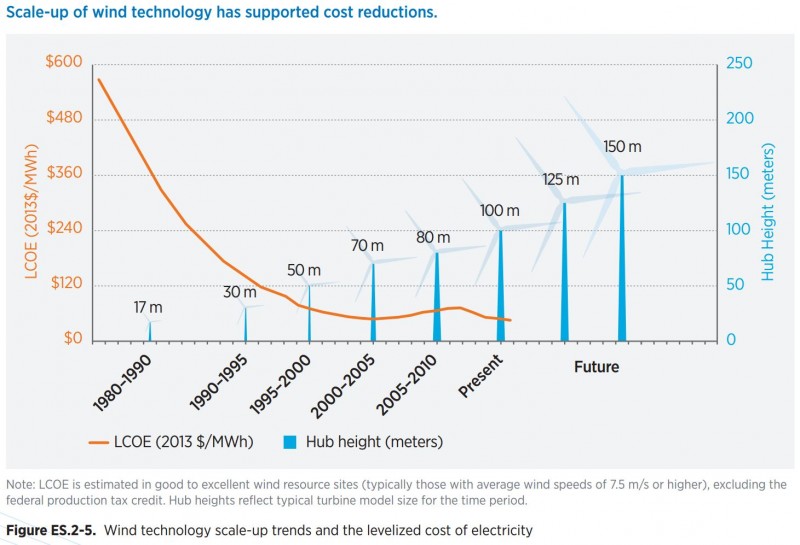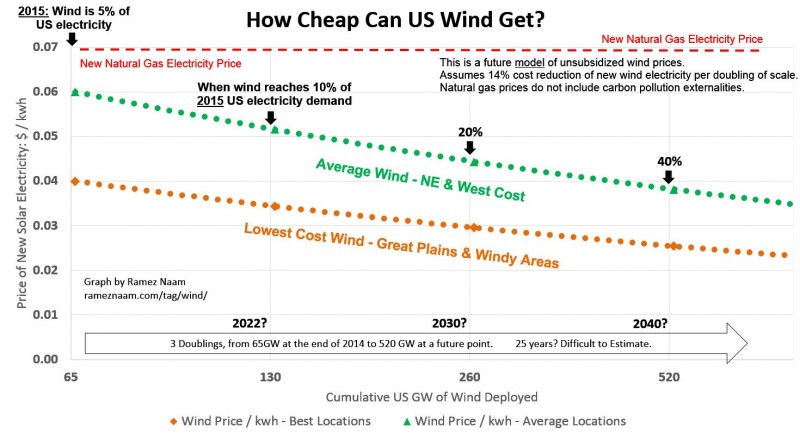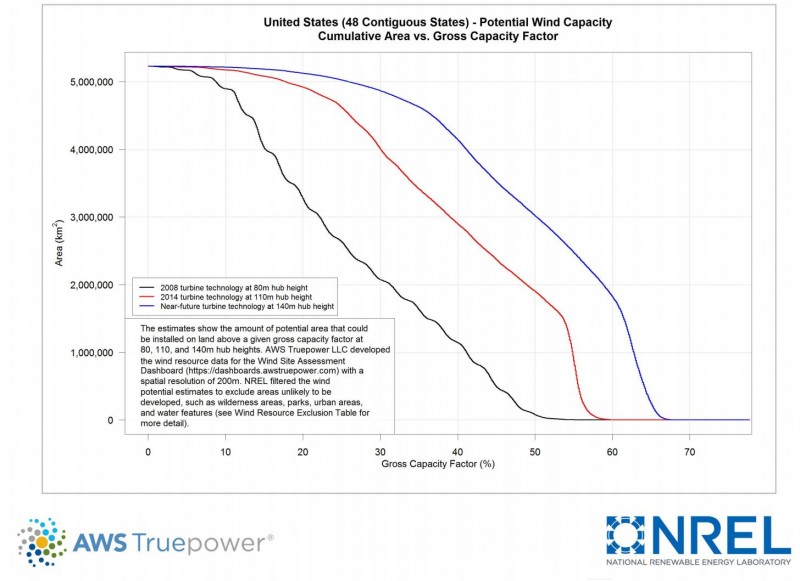Wind
- Wind: fastest growing renewable. Solar electric is second Lovins, 71
Mechanism
- Wind velocity relates to power cubically: W/m^2=(mph)^3/10 Muller, 161
- Just three blades can harvest more than half of the wind energy Muller, 162
- Betz's law: a wind turbine can theoretically extract up to 59% of the wind's power Muller, 162
- "As a general rule of thumb, wind turbines produce electricity equal to the area their blades sweep through. And area is equal to the square of blade length. That means that doubling the tower height and blade length quadruples the area the blades spin through, and generates 4x as much energy. Partially as a result, wind prices per kwh have dropped, even as (or in part because) wind turbines have grown taller."
 Naam
Naam
Opportunity
- Wind can theoretically be a major source of renewable energy, but never 100% of power needs. In 2007, global electricity production was 1,800 TWh (p125). Globally, about 1,200 TW is dissipated within 1km of the earth’s surface– and therefore harvestable Smil, 121
- Wind power requires a lot of land (in windy places). A reasonable assumption of wind power capacity factor (the actual power output divided by the maximum theoretical output) is no higher than 25% based on measurements in Europe, so 4.1 TW of installed capacity would cover half of 2007 global power needs — which would cover a space equal in area to four Frances, assuming 2 W per square meter Smil, 125
- North America is particularly well suited for wind power generation because there is a high land area of strong winds areas distributed across the land. But the continent also has prolonged calms and excessively strong winds; both conditions halt wind power generation Smil, 128
- "Today, peak electricity demand in the US happens during the afternoons and early evenings. Electricity demand in the US is higher in summer months than in winter months. (Note that this pattern differs in Europe, where energy-intensive air-conditioning is less common than the US.) Wind power patterns are nearly the opposite of US electricity demand patterns. Winds tend to max out overnight and in winter months." Naam
Economics
- "In 2014, the average cost of Power Purchase Agreements for new wind power in the US was around 2.35 cents per kwh, the lowest it has ever been. In the windiest parts of the great plains, prices are as low as 2 cents per kwh." Naam
- New natural gas electricity is 7c/kwH; new wind power (unsubsidized) costs an average of 4c/kwH or less Naam
- Wind turbine expenses impacted by materials fluctiations (copper, steel, etc) Naam
 "the trendlines suggest that, by the time wind supplies 20% of US electricity, the unsubsidized cost of wind power at the best sites could be around 3 cents per kwh, and at more typical sites they could be around 4.5 cents per kwh" Naam
"the trendlines suggest that, by the time wind supplies 20% of US electricity, the unsubsidized cost of wind power at the best sites could be around 3 cents per kwh, and at more typical sites they could be around 4.5 cents per kwh" Naam
Barriers
- Main barriers to wind power adoption in the United States: transmission, and wind reliability Naam
- High wind speeds in the United States are typically far from high population density and also from HVDC lines, so high-producing turbines in the United States can't efficiently transmit power where it is needed Naam
- Scaling up wind turbine sizes is limited in part by getting parts onto trucks to get them on site (low bridges etc.) Naam
Improvement opportunities
- Solar and wind are currently expensive to implement, but it's possible to significantly reduce cost for materials/transport/setup without a technological breakthrough, e.g. wind turbines on kites Victor
- Improved software, especially modeling (where should my wind turbine go?) can dramatically increase the efficiency of existing technologies Victor
 "next-generation wind turbines could reach an incredible capacity factor of 60% over 2 million square kilometers of the US, or enough to provide roughly 10x as much electricity as the US uses" Naam
"next-generation wind turbines could reach an incredible capacity factor of 60% over 2 million square kilometers of the US, or enough to provide roughly 10x as much electricity as the US uses" Naam
Further research to do
- "Harnessing High Altitude Wind Power" http://xa.yimg.com/kq/groups/20593576/1580747992/name/Roberts_etal_IEEE_Trans_on_Energy_Conv_2007.pdf
- Reading throughout http://www.skywindpower.com/ww/
- Magenn tethered turbine doesn't seem to have news since 2009- why?
[aggarwal]: https://www.sciencedirect.com/science/article/pii/S1040619013001917 "Aggarwal, Sonia and Harvey, Hal. 'Rethinking Energy Policy to Deliver a Clean Energy Future.' Energy Innovation, 2013."
[trabish-dynamic]: https://www.utilitydive.com/news/beyond-tou-is-more-dynamic-pricing-the-future-of-rate-design/447171/ "Trabish, Herman. 'Beyond ToU: Is more dynamic pricing the future of rate design?' Utility Dive, 2017."